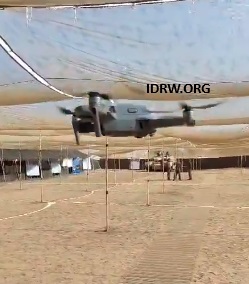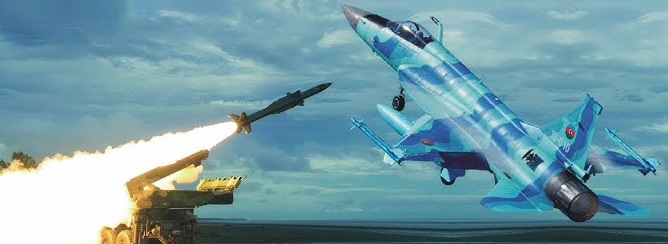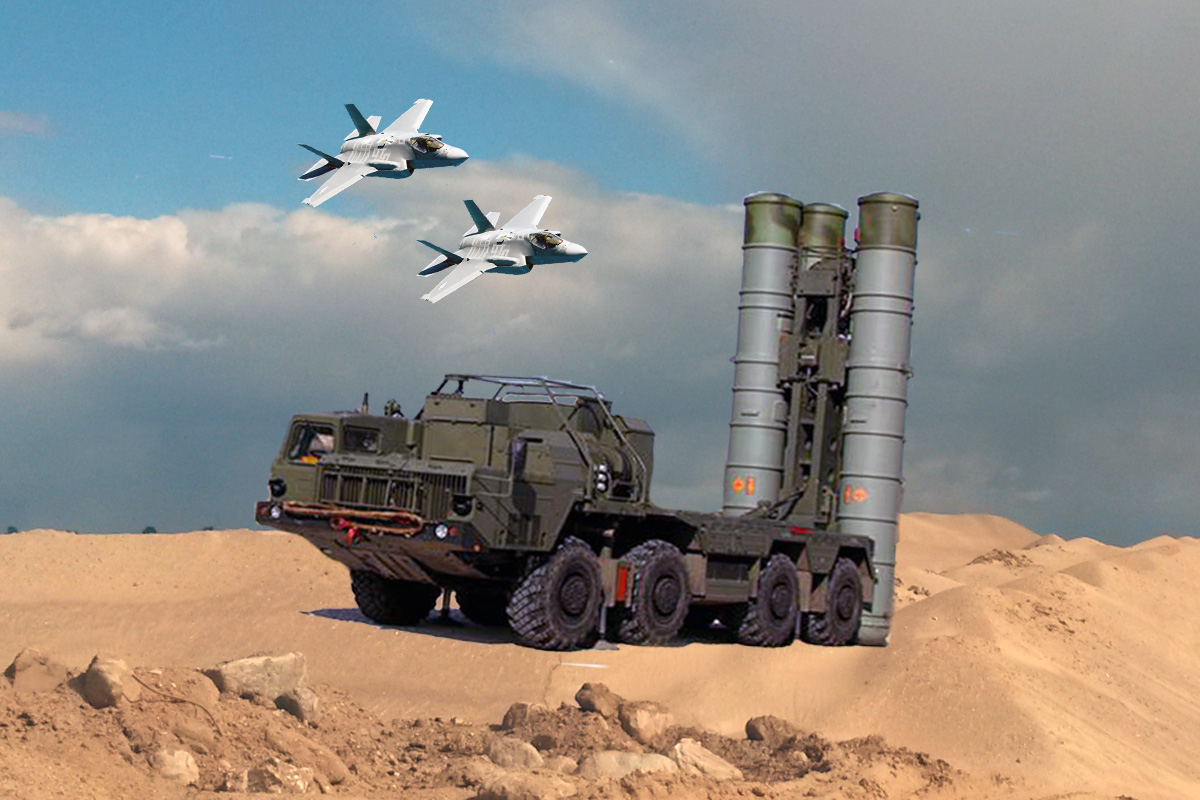Monthly Archives: October 2024
SOURCE: IDRW.ORG

JSR Dynamics Private Limited, a Nagpur-based company, has showcased its latest development – a Blended Wing Body UAV airframe. This innovative design has garnered significant attention in the defense and aerospace industry.
While the company has not disclosed many specifics about the Blended Wing Body UAV, it is likely to be powered by a mini jet-powered engine. This suggests that the UAV could potentially be as large as the Iranian jet-powered Shahed-238 kamikaze drones.
Continue readingSOURCE: IDRW.ORG

New Delhi-based Botlab Dynamics, an iDEX winner, showcased its innovative disposable lightweight drone at the recent 20th India-US YudhAbhyas exercise. This cutting-edge technology is poised to significantly enhance battlefield intelligence for the Indian Army and Navy.
The disposable drone, equipped with day/night surveillance capabilities and beyond-line-of-sight (BLOS) functionality, is designed to provide ground soldiers with real-time situational awareness. Its ability to assess battle damage further underscores its potential to revolutionize tactical operations.
Continue readingSOURCE: AFI

As three decades of hostilities between Armenia and Azerbaijan continue to simmer, a new phase in the conflict is taking shape, marked by the introduction of advanced air defense systems and fighter jets. Armenia has recently placed significant orders for India’s Akash 1S air defense interceptor missile system, while Azerbaijan has bolstered its air capabilities with JF-17 fighter jets developed by Pakistan and China. These acquisitions signal a potential shift in the military balance between the two nations, with both seeking to enhance their strategic advantages.
The Akash 1S air defense system, developed by India’s Defence Research and Development Organisation (DRDO), is poised to become the backbone of Armenia’s air defense network. Armenia’s decision to acquire the Akash 1S is a key part of its strategy to replace its aging Soviet-era air defense systems, which are now considered obsolete in the face of modern aerial threats.
Continue readingSOURCE: AFI

The advent of fifth-generation fighter jets like the F-35 Lightning II has revolutionized modern aerial warfare, challenging traditional air defense systems such as Russia’s S-400. The F-35, with its cutting-edge stealth technology, presents a significant hurdle for systems like the S-400, which are designed to track and engage a wide variety of aerial threats. Understanding the interaction between these technologies is crucial, especially as countries like India and Turkey, both operators of the S-400, navigate complex defense strategies in an era defined by advanced stealth platforms.
The F-35 Lightning II is a multi-role, fifth-generation fighter jet developed by Lockheed Martin for the United States and its allies. Its defining feature is its stealth technology, which allows it to evade detection by radar systems. The aircraft’s design minimizes its radar cross-section (RCS), making it nearly invisible to traditional radar systems. Additionally, it employs advanced electronic warfare (EW) capabilities to jam or confuse enemy radar systems, making it even more difficult to detect and track.
Continue readingSOURCE: AFI

In a move aimed at bolstering its operational capabilities in the challenging terrain of India’s northern borders, the Indian Army is seeking to hire helicopters from civil agencies. These helicopters will be tasked with a variety of duties, including logistics support, troop transportation, and casualty evacuation.
The Army plans to deploy these single-engine helicopters in select sectors of Jammu and Kashmir and Ladakh. These include Drass, Kargil, Batalik, Doda, Kishtwar, and Gurez. While the helicopters will be primarily operational during the winter months (November to April), their deployment may be extended to other periods as required.
Continue readingSOURCE: AFI

In a major diplomatic victory, India has secured a contract from Russia to construct four non-nuclear icebreaker ships. This decision marks a significant step forward in the India-Russia strategic partnership and positions India as a key player in Arctic affairs.
Russia’s choice to partner with India for this project is primarily driven by the challenges it faces due to Western sanctions. The NSR, a crucial maritime route connecting Europe and Asia, has become increasingly important for Russia’s economic development. However, the sanctions have limited Russia’s access to Western technology and equipment, making it difficult to build the icebreakers needed to navigate the Arctic waters.
Continue readingSOURCE: AFI

In a strategic move to counter China’s growing military presence along the Line of Actual Control (LAC), the Indian Ministry of Defense and the Indian Air Force are planning to take over three existing airstrips in Uttarakhand and construct a new one in the Spiti area of Himachal Pradesh.
Sources indicate that negotiations are underway to acquire the airstrips at Pithoragarh, Gauchar, and Dharasu in Uttarakhand. Additionally, a feasibility study has been conducted for a new airstrip at Rangrik in Spiti. These expansions aim to enhance India’s aerial capabilities and bolster its defense posture in the region.
Continue readingSOURCE: ANI

The month of September 2024 witnessed a series of significant defence procurement and development initiatives by the Government of India (GoI), aimed at bolstering the country’s military capabilities and enhancing its strategic position in the global defence landscape.
One of the key highlights of September was the Defence Acquisition Council (DAC) approving 10 capital acquisition proposals worth Rs 145 billion. The approvals include the procurement of Future-Ready Combat Vehicles (FRCVs), which will significantly enhance the Army’s mobility and firepower. In addition to the FRCVs, the DAC approved seven Project 17B stealth frigates for the Indian Navy, at an estimated cost of Rs 700 billion. The frigates will strengthen the Navy’s maritime defence capabilities and improve its surface warfare tactics.
Continue readingSOURCE: ANI

Canadian Member of Parliament, Chandra Arya has strongly condemned the recent attacks on journalists reporting on Khalistani extremism in Canada. Addressing the Canadian Parliament, Arya, who is the MP from Nepean, Ontario, urged law enforcement agencies to take the issue of Khalistani extremism in the country seriously. Sharing a post on X, he said, “My statement in parliament today: I am very concerned by attacks on journalists who report on Khalistani extremism in Canada.
Few days back, Rishi Nagar of Red FM Calgary was severely attacked. In March 2023 Sameer Kaushal of Radio AM600, Richmond, BC was assaulted for covering a Khalistan protest.” He added, “In February 2022, Brampton radio host Deepak Punj was attacked in his studio for criticizing Khalistan-related violence. Anti-terrorism investigative journalist Mocha Bezirgan has received death threats for his fearless reporting on Khalistani extremism.”
Continue readingSOURCE: UNI

India on Friday said that “there was no substantive discussion” between Prime Minister Narendra Modi and Canadian PM Justin Trudeau in Vientiane, and emphasised that Ottawa needs to take firm action, which has been lacking thus far, against anti-India Khalistani activities on Canadian soil. Canadian PM Trudeau said at a press conference that he had a “brief exchange” with Prime Minister Modi in Vientiane.
Sources said that “India continues to expect that anti-India Khalistani activities will not be allowed to take place on Canadian soil and that firm action, which is lacking thus far, will be taken against those advocating violence, extremism and terrorism against India from Canadian territory.” The sources added that the “growing nexus of such forces with organized crime, drug syndicates and human trafficking should be a concern for Canada as well”.
Continue readingSOURCE: PTI

India has backed a joint statement by the UNIFIL-contributing countries that “strongly condemned” the recent attacks on the UN peacekeeping force in Lebanon and said such actions must stop immediately.
The joint statement, initially co-signed by 34 countries, came after at least five United Nations Interim Force in Lebanon (UNIFIL) peacekeepers were wounded in recent days as Israeli troops launched attacks in southern Lebanon as part of its campaign against Hezbollah.
Continue readingSOURCE: ANI

The 23rd Council of the Heads of Government (CHG) of the Member States of the Shanghai Cooperation Organisation (SCO) will take place in Islamabad, Pakistan, from October 15 to 16, ARY News reported on Saturday. According to a statement from the Pakistan Foreign Office, Prime Minister Shehbaz Sharif will chair the upcoming CHG meeting.
The Prime Minister of China Li Qiang, Prime Minister of Russia Mikhail Mishustin, Prime Minister of Belarus Roman Golovchenko, Prime Minister of Kazakhstan Olzhas Bektenov, Prime Minister of Kyrgyzstan Akylbek Zhaparov, Prime Minister of Tajikistan Akylbek Zhaparov, and Prime Minister of Uzbekistan Abdulla Nigmatovich Aripov, as well as the first Vice President of Iran Mohammad Mokhber and the External Affairs Minister S Jaishankar, will represent the SCO member states during the summit, ARY News reported.
Continue readingSOURCE: PIB
CrossDeckVisits8B0Q.jpeg)
As part of the ongoing harbour activities during the Multilateral Maritime Exercise Malabar 2024, participating navies – India, Australia, Japan, and the United States – have been actively engaged in various collaborative events since 09 Oct 24, at Visakhapatnam, coordinated by the Eastern Naval Command. These activities include Key Leadership Engagement (KLE), Subject Matter Expert Exchange (SMEE), cross-deck visits, sports fixtures, and pre-sailing discussions, all aimed at enhancing maritime cooperation, building camaraderie, and fostering operational synergy.
Key leadership engagement of the senior naval hierarchy has been a special feature of the exercise, with Vice Admiral Rajesh Pendharkar, Flag Officer Commanding-in-Chief (FOC-in-C), Eastern Naval Command, Admiral Stephen Koehler, Commander US Pacific Fleet, Vice Admiral Katsushi Omachi, Commander-in-Chief, Self-Defense Fleet, Japan, and Rear Admiral Chris Smith, Commander Australian Fleet, meeting to discuss ways to strengthen mutual naval interoperability and cooperation in the Indo-Pacific region, as well as the future of Malabar exercises.
Continue readingSOURCE: UNI

BRICS has never been and is not planning to become a military union, despite any allegations to the contrary, the Russian Foreign Ministry said. “BRICS is not, has never been and is not going to become a military union. BRICS is not even an international organisation or an integration structure, but a multinational union of equal members,” the ministry said in a statement on Saturday, commenting on an article published in The Times in September, which suggested that the extension of BRICS “should worry NATO.
” BRICS is a multidisciplinary strategic partnership that rests on three pillars: politics and security, economics and finance, and culture and humanitarian ties, the ministry added. “Relations between the BRICS partners are based on equality, mutual respect, openness, pragmatism, solidarity and, which is the most important of all, not opposing anyone,” the statement read.
Continue readingSOURCE: PIB
KHFL.jpeg)
Indian Naval Ships Tir and Shardul along with Indian Coast Guard Ship Veera of the First Training Squadron (1TS) concluded visit to Muscat, Oman on 09 Oct 24. During the four day visit, the Indian Navy engaged with Royal Navy of Oman on various fronts, forging deeper bonds and strengthening the Bridges of Friendship between two maritime nations.
VAdm V Srinivas, Flag Officer Commanding-in-Chief, Southern Naval Command (FOCINC, South) along with Commanding Officers of visiting ships called on VAdm Abdullah Bin Khamis Bin Abdullah Al Raisi, Chief of Staff Sultan’s Armed Forces (COSSAF) and RAdm Saif bin Nasser bin Mohsen Al- Rahbi, Commander of Royal Navy of Oman (CRNO). The discussions were focused on enhancing defence cooperation through avenues of training exchanges, shared knowledge and joint training exercises. During the visit, FOCINC (South) emphasised the importance of growing strategic partnership, greater engagement & interoperability between the two Navies.
Continue reading